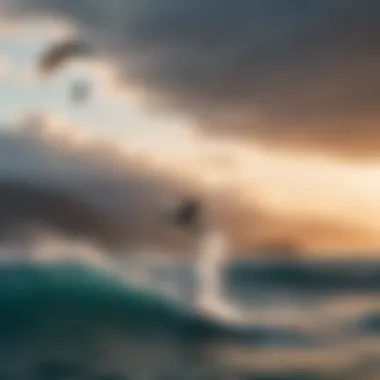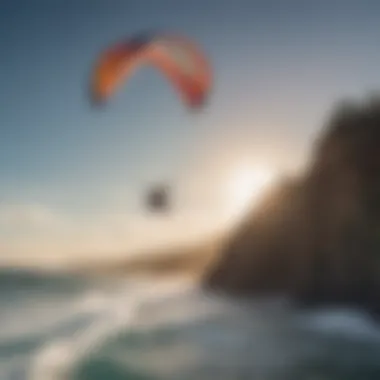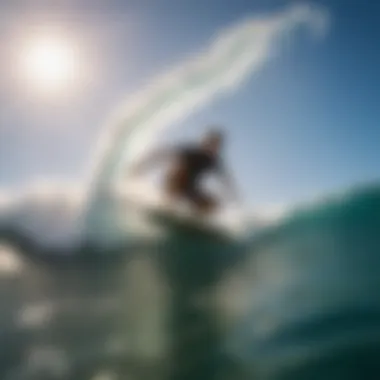Unveiling the Thrilling Universe of Kite Surfing Amidst Hawaii's Breathtaking Landscapes


Equipment Reviews
Kite surfing enthusiasts are constantly on the lookout for the latest advancements in kite technology to enhance their surfing experience. Understanding the intricacies of various kite models, including their shapes, sizes, materials, and performance capabilities, is crucial for riders seeking optimal performance. With a plethora of brands offering a diverse range of kites, from freestyle to wave-specific designs, riders can choose based on their riding style and preferences.
Kites Shapes, Sizes, and Materials
The shape and size of a kite significantly influence its performance on the water. From bow kites to delta kites, each design offers distinct advantages suited to different riding conditions. Larger kites provide more power and lift, ideal for light wind days, while smaller kites offer greater maneuverability and speed in stronger winds. Furthermore, the materials used in kite construction, such as ripstop nylon or polyester fabrics, impact the kite's durability, weight, and responsiveness.
Kite Brands
Leading kite manufacturers like Naish, Cabrinha, and Duotone are renowned for their innovation and high-quality products. Each brand boasts a unique lineup of kites catering to diverse skill levels and riding preferences. Riders can explore an array of options, from beginner-friendly kites for stable control to high-performance models for adrenaline-fueled sessions.
Boards
Apart from kites, the choice of board significantly influences a kite surfer's riding experience. Twin tips, directional boards, and foil boards each offer distinct advantages based on the rider's skill level, riding style, and the conditions of the day. Understanding the design, construction, and riding style suitability of different boards is essential for selecting the ideal board for a thrilling session on the water.
Twintips and Directional Boards
Twintip boards, characterized by their symmetrical shape and bindings on both ends, are versatile for various riding styles, including freestyle tricks and cruising. In contrast, directional boards are designed with a prominent nose and tail, optimal for wave riding and creating smooth carves in the surf. Riders can choose a board based on their preferred riding style and the type of conditions they encounter.
Accessories
In the realm of kite surfing, essential accessories play a critical role in ensuring a safe and enjoyable experience on the water. Harnesses, lines, pumps, safety gear, and other accessories are indispensable components of a kite surfer's toolkit, offering comfort, control, and security throughout their sessions. Understanding the importance of each accessory and its impact on performance is vital for riders seeking to elevate their kite surfing skills.
Harnesses and Lines
Harnesses provide riders with the necessary support and distribute the pull of the kite across the body, reducing fatigue and enhancing control. Various harness designs, such as waist or seat harnesses, cater to different riding preferences and comfort levels. Additionally, lines connect the kite to the bar, transmitting control inputs to steer the kite and execute maneuvers effectively.
Safety Gear and Equipment Maintenance
Prioritizing safety gear, such as helmets, life jackets, and impact vests, is paramount for mitigating risks and ensuring a secure kite surfing experience. Awareness of emergency protocols, rescue tactics, and equipment maintenance routines is essential for riders navigating unpredictable water conditions and unforeseen challenges. Regular inspections and upkeep of gear guarantee optimal performance and longevity, safeguarding riders during their adrenaline-fueled adventures on the water.
Introduction
Kite surfing in Hawaii, a compelling fusion of adrenaline and natural beauty, encapsulates the essence of adventure against the backdrop of picturesque landscapes. As kitesurfing continues to attract thrill-seekers and watersport enthusiasts alike, Hawaii emerges as a premier destination synonymous with excitement and challenge. The juxtaposition of Hawaii's diverse geographical features - from volcanic mountains to lush rainforests and turquoise waters - sets the stage for an unrivaled kitesurfing experience. In this article, we embark on a journey to uncover the secrets of kite surfing in Hawaii, exploring the wind conditions, popular spots, equipment essentials, safety protocols, and the vibrant community and culture that pervades this exhilarating sport. By delving into this distinct realm of water sports, we aim to paint a vivid portrait of kite surfing in Hawaii, catering to the curiosity and passion of kitesurfers and adventure seekers seeking the ultimate aquatic thrills.
The Beauty of Hawaii
Hawaii's beauty is a pivotal aspect of this article, setting a breathtaking backdrop for the intense world of kite surfing. The diverse landscape of Hawaii enchants visitors with its array of volcanic mountains, lush rainforests, and mesmerizing turquoise waters. This natural variety not only paints a stunning scene but also offers unique experiences for kite surfers seeking adventure and thrill amidst unparalleled beauty.
Diverse Landscape of Hawaii


Volcanic Mountains
The volcanic mountains in Hawaii stand as iconic figures, shaping the island's terrain and providing a dramatic backdrop against the expansive seas. These majestic peaks not only add to the visual allure of Hawaii but also influence its wind patterns, crucial for kite surfers looking for optimal conditions. The craggy landscapes of volcanic mountains offer a thrilling terrain for exploration and adventure, making them a popular choice for those seeking a raw and untouched natural experience.
Lush Rainforests
Hawaii's lush rainforests are verdant wonders, teeming with biodiversity and vibrant flora and fauna. These dense forests not only serve as havens for wildlife but also create a lush contrast to the surrounding volcanic landscapes. Kite surfers can find solace and serenity within the cool shade of these tropical havens, providing a soothing escape after an intense session on the waves. The rich ecosystems of lush rainforests contribute to the wellbeing of Hawaii's environment, making them an essential part of the island's charm.
Turquoise Waters
The turquoise waters surrounding Hawaii's shores are a sight to behold, crystal clear and inviting. These pristine waters offer kite surfers a playground of endless possibilities, where they can ride the waves under the warm Hawaiian sun. The allure of turquoise waters lies not only in their scenic beauty but also in the diverse marine life that calls these waters home. Kite surfers can bask in the refreshing embrace of these waters, adding a touch of tranquility to their adrenaline-fueled adventures.
Breathtaking Beaches
Waikiki Beach
Waikiki Beach stands as an emblem of Hawaii's beach culture, with its bustling atmosphere and golden sands. This iconic beach offers kite surfers a vibrant setting to launch into the azure waters, with steady winds and clear skies calling enthusiasts from near and far. The bustling beachfront of Waikiki provides ample opportunities for kite surfers to mingle with fellow adrenaline junkies, creating a sense of community amidst the crashing waves.
Maui's Ka'anapali Beach
Maui's Ka'anapali Beach stretches as a golden ribbon along Maui's western coast, a prime location for kite surfing enthusiasts seeking a blend of adventure and relaxation. The consistent winds off the coast of Ka'anapali Beach make it an ideal spot for kite surfing, with panoramic views of neighboring islands adding to the allure. Kite surfers can revel in the thrill of riding the waves while taking in the majestic beauty of Maui's coastline, creating unforgettable moments in this tropical paradise.
Big Island's Hapuna Beach
Big Island's Hapuna Beach caters to kite surfers looking for a more laid-back and secluded experience. The expansive sands of Hapuna Beach provide ample space for kite surfing enthusiasts to take flight, with gentle waves and warm waters offering an idyllic setting for beginners and seasoned surfers alike. The tranquil ambiance of Hapuna Beach sets it apart as a peaceful retreat for kite surfers, allowing them to immerse themselves in the raw beauty of Hawaii's coastlines while exploring the exhilarating world of kite surfing.
Kite Surfing in Hawaii
Kite Surfing in Hawaii is a captivating topic to explore in the context of this article. Hawaii, with its diverse landscape and breathtaking beaches, offers the perfect backdrop for this exhilarating sport. Kite surfing enthusiasts are drawn to the pristine turquoise waters and challenging wind conditions that Hawaii is known for. The fusion of adrenaline-pumping activity against the stunning Hawaiian scenery creates a unique experience for thrill-seekers and outdoor enthusiasts alike.
Exhilarating Sport
Wind Conditions
Wind conditions play a crucial role in kite surfing, as they determine the feasibility and excitement of the sport. Hawaii's consistent trade winds provide ideal conditions for kite surfing, attracting enthusiasts from around the world. The steady breeze ensures a thrilling ride for experienced kite surfers while offering a stable learning environment for beginners. Despite occasional gusts, the prevailing winds in Hawaii enhance the overall kite surfing experience by offering a reliable and enjoyable session.
Popular Spots
Hawaii boasts numerous popular spots for kite surfing, each with its own unique charm and appeal. From the renowned shores of Waikiki Beach to the expansive stretch of Maui's Ka'anapali Beach and the secluded beauty of Big Island's Hapuna Beach, kite surfers have a variety of locations to explore. These spots not only offer diverse scenery and wind patterns but also a sense of community among surfers. The popularity of these destinations lies in their blend of natural beauty, favorable wind conditions, and vibrant kite surfing culture.
Safety in Kite Surfing
Equipment


The right equipment is essential for ensuring safety and success in kite surfing. High-quality gear, including a kiteboard, kite, and harness, is crucial for maneuvering through the waves and winds effectively. Investing in reliable equipment that suits the rider's skill level and the specific conditions of Hawaii's waters is paramount for a positive kite surfing experience. While the gear enhances performance, it also contributes to the overall safety of the rider.
Training
Proper training is key to mastering kite surfing techniques and navigating the challenges of the sport. Enrolling in lessons with experienced instructors not only enhances skills but also emphasizes safety protocols and situational awareness. Training sessions cover essential topics like launching and landing the kite, controlling speed, and handling emergencies. Adequate training not only fosters skill development but also instills confidence in kite surfers, enabling them to enjoy the sport responsibly.
Community and Culture
Local Bonding
Kite surfing in Hawaii is not just about the sport itself but also about the sense of community it fosters among enthusiasts. Local bonding is an integral part of the kite surfing culture in Hawaii, where surfers come together to share knowledge, experiences, and camaraderie. Whether exchanging tips on wind patterns or celebrating successful runs, the kite surfing community in Hawaii creates a supportive and inclusive environment for individuals passionate about the sport.
Events
Hawaii hosts a variety of kite surfing events that showcase talent, innovation, and camaraderie within the community. From competitions that challenge riders' skills to fun gatherings that promote a festive atmosphere, these events contribute to the vibrant kite surfing culture in Hawaii. Attending such events not only allows participants to test their abilities but also encourages networking and learning from fellow enthusiasts. The exciting lineup of events adds an extra layer of thrill and excitement to the kite surfing scene in Hawaii.
Gear and Equipment
When delving into the thrilling world of kite surfing in Hawaii, the significance of gear and equipment cannot be overstated. The right gear can make all the difference in ensuring a safe and enjoyable kite surfing experience. From kites to boards, each piece of equipment plays a crucial role in the sport.
Essential Gear
Kiteboard
The kiteboard is a fundamental component of kite surfing, serving as the platform on which surfers stand while harnessing the power of the kite. Its design and construction directly impact the rider's performance and control on the water. A key characteristic of a kiteboard is its buoyancy and lightweight nature, allowing for easy maneuverability and tricks. Choosing the right kiteboard is essential for riders looking to enhance their skills and progress in the sport.
Kite
The kite is the engine of kite surfing, generating the power needed to propel riders across the water. Different kites offer varying sizes and shapes, catering to different wind conditions and rider preferences. A crucial feature of a kite is its ability to depower and control, ensuring safety and stability during maneuvers. Selecting the correct kite can significantly impact a kitesurfer's performance and enjoyment on the waves.
Harness
The harness connects the rider to the kite, transferring the pulling force from the kite through the lines to the kitesurfer. It provides support and distributes the kite's power, reducing strain on the rider's arms and allowing for longer sessions on the water. The key characteristic of a harness is its comfort and fit, ensuring freedom of movement while maintaining control over the kite. Finding the right harness that suits the rider's body type and riding style is crucial for a successful and comfortable kite surfing experience.
Advanced Equipment
Foils
Foils, also known as hydrofoils, are advanced components that elevate the kiteboard above the water, reducing drag and increasing speed. Their design allows riders to glide smoothly over choppy waters and perform aerodynamic maneuvers. A key characteristic of foils is their efficiency in harnessing wind power and reducing resistance, resulting in a faster and more exhilarating ride. While foils require skilled handling and practice, they offer experienced kitesurfers a thrilling way to explore new tricks and techniques.
Boards


Boards come in various shapes and sizes, each designed for specific riding styles and conditions. From twin tips for freestyle tricks to directional boards for wave riding, choosing the right board can enhance performance and versatility on the water. A key characteristic of boards is their stability and responsiveness, allowing riders to carve through waves and execute dynamic maneuvers with precision. Whether seeking speed, agility, or wave-riding capabilities, selecting the appropriate board is crucial for maximizing the kite surfing experience in Hawaii.
Kite Surfing Techniques
In the realm of kite surfing in Hawaii, mastering the essential kite surfing techniques is paramount for an exhilarating and safe experience on the turquoise waters. Kite surfing techniques encompass a range of maneuvers that enable riders to harness the power of the wind effectively. From basic moves to advanced tricks, each technique plays a crucial role in the rider's performance and enjoyment on the waves. Understanding and honing these techniques not only elevates the excitement of the sport but also ensures the kite surfer's proficiency and safety.
Basic Moves
Body Drag
Body drag, a fundamental technique in kite surfing, involves using the power of the kite to propel oneself through the water without the board. This maneuver serves as a crucial skill for regaining control of the board if it gets detached or for navigating back to shore in challenging conditions. The key characteristic of body drag lies in its ability to enhance a rider's water awareness and maneuverability. While body drag may seem basic, its importance cannot be overstated, especially in emergency situations or when facing strong currents. Although body drag is essential for all kite surfers, mastering this technique takes practice and patience. Its advantage lies in its utility as both a practical skill and a safety measure, making it a vital component of every kite surfer's repertoire.
Water Start
The water start technique is the gateway to getting up on the board and gliding gracefully across the water's surface. With water start, riders learn to position themselves correctly in the water, manage the kite's power efficiently, and initiate motion on the board. The key characteristic of water start is its role in transitioning from body dragging to board riding, marking the beginning of an exhilarating kite surfing session. This technique is popular among beginners for its significance in initiating their kite surfing journey and experiencing the thrill of riding the waves. While mastering the water start may pose initial challenges, its benefits in launching into the world of kite surfing are immense. Its advantage lies in providing the foundation for further skill development and opening up opportunities for more advanced maneuvers on the board.
Advanced Tricks
Jumps
Jumps in kite surfing add an element of acrobatics and excitement to the rider's experience on the water. By harnessing the wind's power and the kite's lift, riders can propel themselves into mid-air maneuvers that showcase skill and daring. The key characteristic of jumps lies in the adrenaline rush and visual spectacle they offer, captivating both the surfer and onlookers. Jumps are a popular choice among experienced riders looking to push their boundaries and execute impressive aerial stunts. The unique feature of jumps is their ability to combine technical prowess with sheer thrill, making them a sought-after skill in the kite surfing community. While jumps can be challenging to master due to their dynamic nature, the rewards of executing a perfect jump are unparalleled. Their advantage lies in adding a dynamic and dramatic flair to a rider's repertoire, elevating their overall kite surfing performance.
Loops
Loops, another advanced trick in kite surfing, involve looping the kite in continuous motion while maintaining control and speed. This dynamic maneuver requires precision, timing, and finesse to execute smoothly and safely. The key characteristic of loops is the loop's energy and momentum, propelling the rider through exhilarating turns and spins. Loops are a popular choice among thrill-seekers and advanced riders seeking to enhance their aerial routines and add flair to their performances. The unique feature of loops lies in their visual appeal and technical complexity, demanding a high level of skill and coordination from the surfer. While loops may present challenges in terms of control and timing, mastering this trick unlocks a new dimension of excitement and skill in kite surfing. Their advantage lies in pushing the boundaries of creativity and difficulty, showcasing the rider's expertise and artistry in mastering the art of kite surfing.
Travel Tips for Kite Surfers
When diving into the world of kite surfing in Hawaii, it is crucial to understand the significance of travel tips for kite surfers. Navigating the logistics of traveling to and around this tropical paradise plays a vital role in ensuring a smooth and enjoyable experience. Whether it's choosing the right accommodation or exploring the local cuisine, these travel tips can enhance the overall kite surfing adventure.
Accommodation
Beachfront Resorts
Beachfront resorts stand out as a prominent choice for kite surfers looking to bask in luxury while staying close to the action. The allure of waking up to the soothing sound of ocean waves and having instant access to pristine beaches makes beachfront resorts a popular option. These resorts often offer exclusive amenities such as beachfront bars, water sports facilities, and stunning ocean views, adding a touch of extravagance to the kite surfing expedition. However, it's essential to consider that beachfront resorts may come with a higher price tag and limited availability, especially during peak travel seasons.
Airbnb Options
On the other hand, Airbnb options provide a more budget-friendly and versatile choice for kite surfers seeking a home-away-from-home experience. Opting for an Airbnb allows travelers to immerse themselves in local neighborhoods, offering a unique glimpse into Hawaiian culture. The flexibility to choose from a variety of properties, ranging from cozy studios to beachfront villas, grants kite surfers the freedom to tailor their accommodation to suit their preferences. While Airbnb options can be cost-effective and offer a personalized stay, it's essential to thoroughly research and book in advance, considering factors like proximity to kite surfing spots and amenities provided.
Local Cuisine
Fresh Seafood
Indulging in fresh seafood is a culinary delight that kite surfers should not miss out on while exploring Hawaii. The abundance of coastal waters ensures a wide array of seafood options, from succulent shrimp to mouthwatering tuna. Fresh seafood restaurants dotting the Hawaiian coastline offer a farm-to-table experience, guaranteeing the highest quality dishes infused with local flavors. The appeal of savoring a seafood feast after a thrilling kite surfing session adds a touch of gastronomic pleasure to the overall Hawaii experience. However, it's recommended to check for any seafood allergies and dietary preferences before diving into the exquisite Hawaiian seafood fare.
Hawaiian Delicacies
Exploring Hawaiian delicacies introduces kite surfers to a tapestry of unique flavors and traditional dishes that reflect the island's rich culinary heritage. From poi, a staple made from taro, to flavorful kalua pig cooked in an underground oven, Hawaiian delicacies offer a culinary journey unlike any other. Embracing these local specialties provides kite surfers with a deeper understanding of Hawaiian culture and traditions, enriching the overall sensory experience of the kite surfing adventure. While indulging in Hawaiian delicacies adds a cultural dimension to the trip, it's advisable to balance indulgence with dietary considerations and choose establishments renowned for their authenticity and quality.







